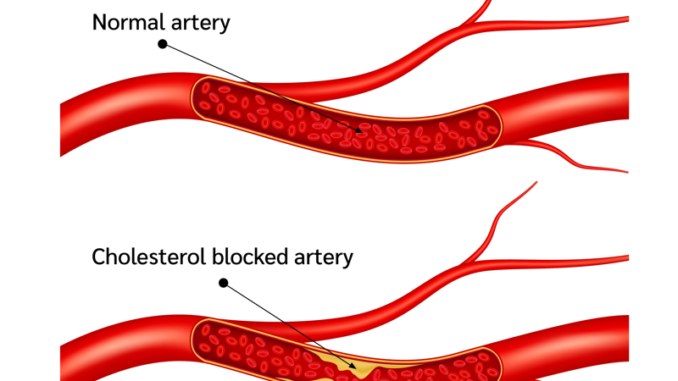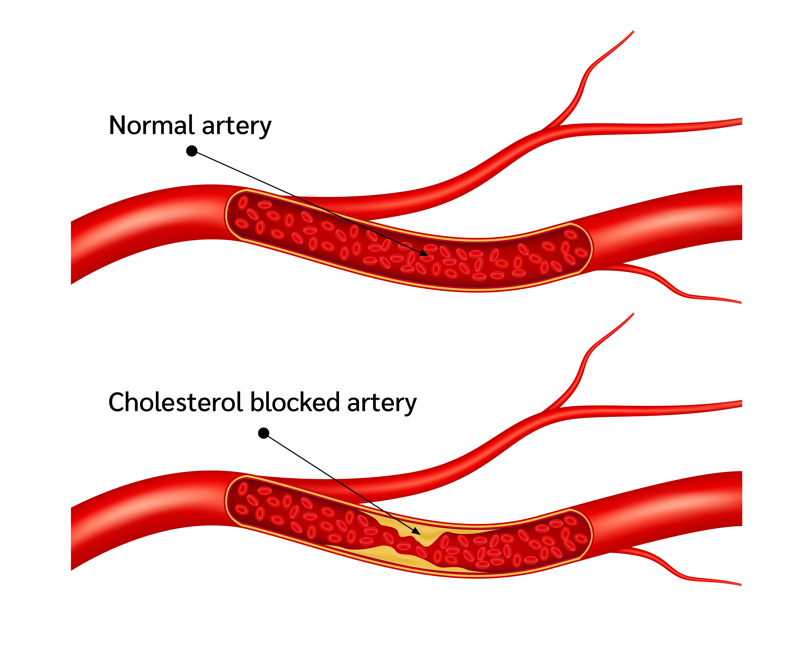
Arteries are blood channels that carry oxygen-rich blood out from the heart and to a variety of other organs and tissues located throughout the body. The coronary arteries are responsible for bringing oxygenated blood to the heart.
A variety of underlying illnesses, bad diets, and unhealthy lifestyles can all contribute to the development of blocked arteries. The chance of developing a number of other types of heart disease can also be increased when arteries become blocked.
Table of Contents
Signs and Symptoms of Blocked Arteries
Signs and symptoms of blocked arteries are quite same across the board for both men and women.
The following is a list of symptoms that are very common:
- It’s possible for the arteries in the neck to get obstructed due to a buildup of fat and calcium deposits.
It is possible to recognize it by its symptoms, which include feeling exhausted and weak, having tingling sensations in the neck, having difficulty speaking, and experiencing discomfort when the neck is moved, among other things.
- If the heart does not receive an adequate quantity of blood that is rich in oxygen, this might lead to aberrant functioning of the cardiac muscles. This can result in the patient developing angina, a condition in which they experience discomfort and agony in the chest area and the surrounding area.
- People who have clogged arteries may experience a buildup of fluids in the pulmonary alveoli in addition to a lack of oxygen-rich blood throughout the body. This may cause agitation, anxiety, and shallow breathing in the affected individual.These are often the symptoms that people with clogged arteries report experiencing the most frequently.
- A rapid or irregular heartbeat, often known as arrhythmia, is another common indication of clogged arteries.
However, it is important to keep in mind that a quick heartbeat can also be the result of physically demanding tasks or high levels of stress.
- Pain in the chest that spreads to the arms, neck, and back may be an indication of arrhythmia, which can also occur in conjunction with blocked arteries.
- In addition to general weakness throughout the body, other symptoms of clogged arteries include excessive sweating, discomfort in the chest region, elevated levels of weariness and so on.

Blocked Arteries – Causes
Many different factors, some of which are described below, can lead to the narrowing or blocking of arteries.
A disorder that causes the arteries to get blocked might be fatal. It is possible for this condition to manifest itself as a sign of a preexisting cardiovascular disease.
People who have high blood pressure are at a greater risk of having their arteries become obstructed. These people also have a much increased risk of experiencing an abnormal rise in their blood pressure, which, if left untreated, can result in coronary heart disease.
Another factor is the formation of blood clots within the arterial blood vessels, which can lead to a significant narrowing of these blood vessels. When the arteries get constricted in this way, it might hinder the process of blood circulation and reduce the amount of oxygen that reaches the heart. In turn, a lower oxygen supply can cause the heart muscles to constrict, which ultimately paves the way for a heart attack to occur.
It is also possible for arterial obstruction to be caused by the buildup of plaque, fatty debris, and calcium in the artery walls. Plaque buildup in the legs can narrow or completely block blood vessels in the lower extremities.
The overuse of the muscles in the legs can hinder the effective functioning of the arteries and result in a number of symptoms including the production of sores and ulcers, difficulty walking, and increasing muscle weakness. These symptoms can be caused by the overuse of the muscles.
In extreme circumstances, blocked arteries in the legs might lead to inadequate or no blood circulation, which can necessitate the amputation of the affected limb.
A blockage in these blood vessels can also be caused by an increased accumulation of fatty material that has been deposited in the arteries.
The body is unable to break down the additional amounts of fat molecules, which leads to elevated levels of LDL cholesterol in the arteries, which in turn causes blockage in the arteries.
People who are obese or overweight have a higher risk of acquiring blocked arteries compared to people who have a normal body weight. Other factors that might lead to artery blockage include the use of tobacco products, excessive consumption of alcohol, diabetes, and various other medical conditions.
Blocked Arteries – Treatment
The precise treatment for arterial blockage is determined by a number of factors, including the severity of the blockage, the severity of the symptoms, the age of the patient, the location of the blocked arteries, and the medical history of the person who is afflicted.
Treatment for mild cases typically involves making changes to one’s lifestyle and taking medication, whereas treatment for severe cases may need surgery or other invasive medical treatments.
The following are some of the potential treatments for arterial blockages:
Medications
If there are any blood clots present, they can be broken up with medications called thrombolytics.
Clot formation is preventable with the use of medications that thin the blood.
There are many medications available to bring the level of cholesterol down.
Analgesic medication are prescribed to relieve painful symptoms . Vasodilators are medications that are recommended to reduce high blood pressure and relax the tightness in the arteries.
Alterations to one’s lifestyle
Maintaining a healthy weight through a combination of regular exercise and dietary modifications can assist in lowering cholesterol levels, which in turn lowers the risk of developing blocked arteries.
Patients are encouraged to follow the instructions stated below:
Stay away from processed foods that contain refined sugars or carbohydrates, as well as sodium or sweeteners that are artificial.
Reduce or eliminate your consumption of foods that are high in cholesterol or saturated fat.
Consume a diet rich in fresh vegetables and fruits in large quantities.
Consume a diet that is high in polyunsaturated as well as monounsaturated fats.
Put an end to smoking and other tobacco products. Reduce or eliminate your consumption of alcoholic beverages.
Consume four to five smaller meals each day. Eat light and frequent meals.
In addition to your regular physical activity, try stress-relieving activities like deep breathing, yoga, meditation, or other similar practices.
Exercise but do not overdo it. In fact, an everday workout of 20 minutes is better than straining yourself at the gym for hours.
Surgical procedures and other intrusive methods
Surgical procedures like atherectomy, endarterectomy angioplasty, and are used to mechanically remove plaque and widen blocked arteries. A bypass surgery involves the use of grafts to reroute the flow of blood.
Authoritative Clinical References
Coronary Artery Disease – https://www.ncbi.nlm.nih.gov/books/NBK564304/


Be the first to comment